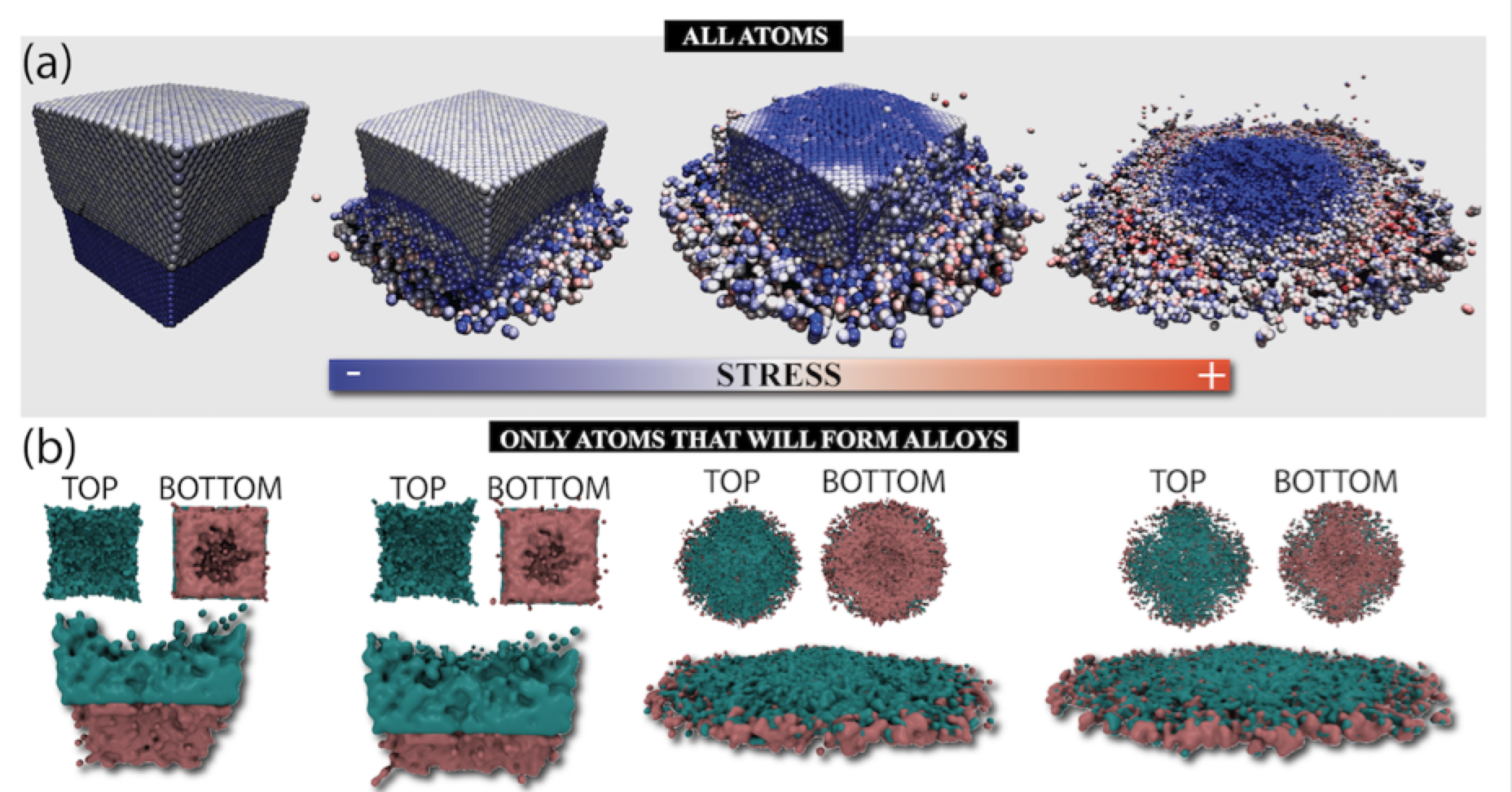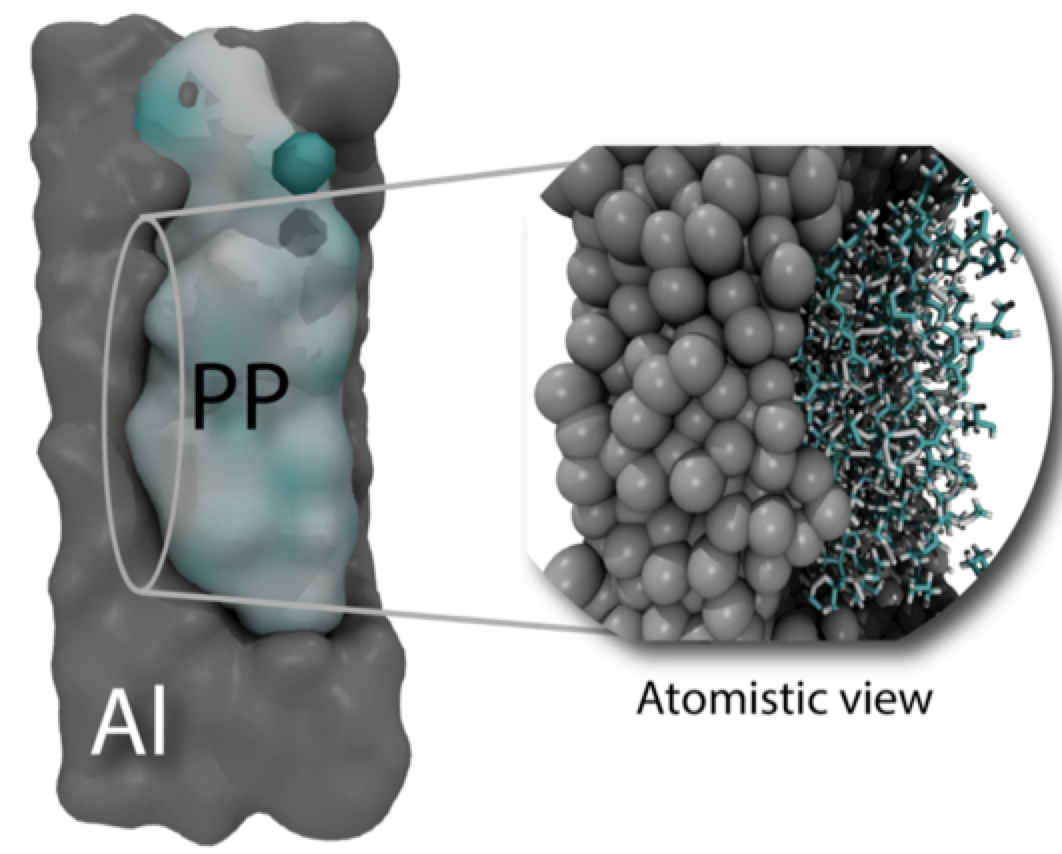Malviya, Kirtman D; Oliveira, Eliezer F; Autreto, Pedro A S; Ajayan, Pulickel M; Galvao, D S; Tiwary, Candra S; Chattopadhyay, Kumanio
Mixing the immiscible through high-velocity mechanical impacts: an experimental and theoretical study Journal Article
In: Journal of Physics D: Applied Physics, vol. 52, no. 44, pp. 445304, 2019.
@article{Malviya2019,
title = {Mixing the immiscible through high-velocity mechanical impacts: an experimental and theoretical study},
author = {Malviya, Kirtman D and Oliveira, Eliezer F and Autreto, Pedro A S and Ajayan, Pulickel M and Galvao, D S and Tiwary, Candra S and Chattopadhyay, Kumanio},
url = {https://iopscience.iop.org/article/10.1088/1361-6463/ab36d1/meta},
doi = {10.1088/1361-6463/ab36d1},
year = {2019},
date = {2019-08-20},
journal = {Journal of Physics D: Applied Physics},
volume = {52},
number = {44},
pages = {445304},
abstract = {In two-component metallic systems, thermodynamic immiscibility leads to phase separation
such as in two-phase eutectic compositional alloys. The limit of the immiscibility of
component elements under non-equilibrium conditions have been explored, but achieving
complete miscibility and formation of single phase microstructures in eutectic alloys would
be unprecedented. Here we report that during low-temperature ball milling that provides high
energy impact, complete mixing of phases can occur in immiscible Ag-Cu eutectic alloys.
From combined theoretical and experimental studies, we show that impact can produce solid
solutions of Ag-Cu nanoparticles of eutectic composition. Our results show that phase
diagrams of low dimensional materials under non-equilibrium conditions remain unexplored
and could lead to new alloy microstructures drastically different from their bulk counterparts.},
keywords = {},
pubstate = {published},
tppubtype = {article}
}
such as in two-phase eutectic compositional alloys. The limit of the immiscibility of
component elements under non-equilibrium conditions have been explored, but achieving
complete miscibility and formation of single phase microstructures in eutectic alloys would
be unprecedented. Here we report that during low-temperature ball milling that provides high
energy impact, complete mixing of phases can occur in immiscible Ag-Cu eutectic alloys.
From combined theoretical and experimental studies, we show that impact can produce solid
solutions of Ag-Cu nanoparticles of eutectic composition. Our results show that phase
diagrams of low dimensional materials under non-equilibrium conditions remain unexplored
and could lead to new alloy microstructures drastically different from their bulk counterparts.
Arpan; Gumaste Rout, Anurag; Pandey
Bio-inspired Aluminum Composite reinforced with Soft polymer with enhanced strength and plasticity (under review) Journal Article
In: 2019.
@article{Rout2019,
title = {Bio-inspired Aluminum Composite reinforced with Soft polymer with enhanced strength and plasticity (under review)},
author = {Rout, Arpan; Gumaste, Anurag; Pandey, Praful; Oliveira, Eliezer; Demiss,
Solomon; P., Mahesh; Bhatt, Chintan; Raphael, Kiran; Ayyagari, Ravi; Autreto, Pedro;
Palit, Mithun; Femi, Olu Emmanuel; Galvao, Douglas; Arora, Amit; Tiwary, Chandra},
year = {2019},
date = {2019-03-30},
keywords = {},
pubstate = {published},
tppubtype = {article}
}
Routa, Arpan; Pandeyb, Praful; Oliveira, Eliezer Fernando; da Silva Autreto, Pedro Alves; Gumastea, Anurag; Singha, Amit; Galvao, Douglas Soares; Aroraa, Amit; Tiwary, Chandra Sekhar
Atomically locked interfaces of metal (Aluminum) and Polymer (Polypropylene) using mechanical friction Journal Article
In: Polymer, vol. 169, pp. 148-153, 2019.
@article{Routa2019,
title = {Atomically locked interfaces of metal (Aluminum) and Polymer (Polypropylene) using mechanical friction},
author = {Arpan Routa and Praful Pandeyb and Eliezer Fernando Oliveira and Pedro Alves da Silva Autreto and Anurag Gumastea and Amit Singha and Douglas Soares Galvao and Amit Aroraa and Chandra Sekhar Tiwary},
year = {2019},
date = {2019-02-23},
journal = {Polymer},
volume = {169},
pages = {148-153},
abstract = {Joining different parts is one of a crucial component of designing/engineering of materials. The current energy, low efficiency weight automotive and aerospace components commonly consist of different class of materials, such as metal, polymer, and ceramics, etc. Joining these components remains a challenge. Here, we demonstrate joining of metal (aluminum) and polymer (PP) using mechanical friction. The detailed characterisation demonstrates that atomically locked interfaces are formed in such joining without the presence of any chemical bond at the interfaces. The waterproof and strong interface is formed in such process. Fully atomistic molecular dynamics simulations were also carried out to provide further insights on these mechanisms.},
keywords = {},
pubstate = {published},
tppubtype = {article}
}
2019

Malviya, Kirtman D; Oliveira, Eliezer F; Autreto, Pedro A S; Ajayan, Pulickel M; Galvao, D S; Tiwary, Candra S; Chattopadhyay, Kumanio
Mixing the immiscible through high-velocity mechanical impacts: an experimental and theoretical study Journal Article
In: Journal of Physics D: Applied Physics, vol. 52, no. 44, pp. 445304, 2019.
Abstract | Links | BibTeX | Tags: Mechanical Properties, Metal, Molecular Dynamics
@article{Malviya2019,
title = {Mixing the immiscible through high-velocity mechanical impacts: an experimental and theoretical study},
author = {Malviya, Kirtman D and Oliveira, Eliezer F and Autreto, Pedro A S and Ajayan, Pulickel M and Galvao, D S and Tiwary, Candra S and Chattopadhyay, Kumanio},
url = {https://iopscience.iop.org/article/10.1088/1361-6463/ab36d1/meta},
doi = {10.1088/1361-6463/ab36d1},
year = {2019},
date = {2019-08-20},
journal = {Journal of Physics D: Applied Physics},
volume = {52},
number = {44},
pages = {445304},
abstract = {In two-component metallic systems, thermodynamic immiscibility leads to phase separation
such as in two-phase eutectic compositional alloys. The limit of the immiscibility of
component elements under non-equilibrium conditions have been explored, but achieving
complete miscibility and formation of single phase microstructures in eutectic alloys would
be unprecedented. Here we report that during low-temperature ball milling that provides high
energy impact, complete mixing of phases can occur in immiscible Ag-Cu eutectic alloys.
From combined theoretical and experimental studies, we show that impact can produce solid
solutions of Ag-Cu nanoparticles of eutectic composition. Our results show that phase
diagrams of low dimensional materials under non-equilibrium conditions remain unexplored
and could lead to new alloy microstructures drastically different from their bulk counterparts.},
keywords = {Mechanical Properties, Metal, Molecular Dynamics},
pubstate = {published},
tppubtype = {article}
}
such as in two-phase eutectic compositional alloys. The limit of the immiscibility of
component elements under non-equilibrium conditions have been explored, but achieving
complete miscibility and formation of single phase microstructures in eutectic alloys would
be unprecedented. Here we report that during low-temperature ball milling that provides high
energy impact, complete mixing of phases can occur in immiscible Ag-Cu eutectic alloys.
From combined theoretical and experimental studies, we show that impact can produce solid
solutions of Ag-Cu nanoparticles of eutectic composition. Our results show that phase
diagrams of low dimensional materials under non-equilibrium conditions remain unexplored
and could lead to new alloy microstructures drastically different from their bulk counterparts.
Arpan; Gumaste Rout, Anurag; Pandey
Bio-inspired Aluminum Composite reinforced with Soft polymer with enhanced strength and plasticity (under review) Journal Article
In: 2019.
BibTeX | Tags: Metal, Molecular Dynamics, Polymers
@article{Rout2019,
title = {Bio-inspired Aluminum Composite reinforced with Soft polymer with enhanced strength and plasticity (under review)},
author = {Rout, Arpan; Gumaste, Anurag; Pandey, Praful; Oliveira, Eliezer; Demiss,
Solomon; P., Mahesh; Bhatt, Chintan; Raphael, Kiran; Ayyagari, Ravi; Autreto, Pedro;
Palit, Mithun; Femi, Olu Emmanuel; Galvao, Douglas; Arora, Amit; Tiwary, Chandra},
year = {2019},
date = {2019-03-30},
keywords = {Metal, Molecular Dynamics, Polymers},
pubstate = {published},
tppubtype = {article}
}

Routa, Arpan; Pandeyb, Praful; Oliveira, Eliezer Fernando; da Silva Autreto, Pedro Alves; Gumastea, Anurag; Singha, Amit; Galvao, Douglas Soares; Aroraa, Amit; Tiwary, Chandra Sekhar
Atomically locked interfaces of metal (Aluminum) and Polymer (Polypropylene) using mechanical friction Journal Article
In: Polymer, vol. 169, pp. 148-153, 2019.
Abstract | BibTeX | Tags: Composites, Metal, Molecular Dynamics, Polymers
@article{Routa2019,
title = {Atomically locked interfaces of metal (Aluminum) and Polymer (Polypropylene) using mechanical friction},
author = {Arpan Routa and Praful Pandeyb and Eliezer Fernando Oliveira and Pedro Alves da Silva Autreto and Anurag Gumastea and Amit Singha and Douglas Soares Galvao and Amit Aroraa and Chandra Sekhar Tiwary},
year = {2019},
date = {2019-02-23},
journal = {Polymer},
volume = {169},
pages = {148-153},
abstract = {Joining different parts is one of a crucial component of designing/engineering of materials. The current energy, low efficiency weight automotive and aerospace components commonly consist of different class of materials, such as metal, polymer, and ceramics, etc. Joining these components remains a challenge. Here, we demonstrate joining of metal (aluminum) and polymer (PP) using mechanical friction. The detailed characterisation demonstrates that atomically locked interfaces are formed in such joining without the presence of any chemical bond at the interfaces. The waterproof and strong interface is formed in such process. Fully atomistic molecular dynamics simulations were also carried out to provide further insights on these mechanisms.},
keywords = {Composites, Metal, Molecular Dynamics, Polymers},
pubstate = {published},
tppubtype = {article}
}
http://scholar.google.com/citations?hl=en&user=95SvbM8AAAAJ


